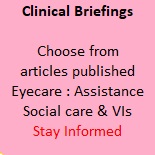Professional Matters Optometry & Dispensing
How community optometry reduces pressures on NHS
How community optometry reduces pressures on NHS
Community optometrists are playing a vital role in reducing demand on the NHS – and can do more.
A new Specsavers access to care report highlights that community glaucoma services, when commissioned, can cut hospital eye visits by around 50%, potentially freeing up 300,000 hospital eye appointments for patients who need them most in England if available nationwide.
Glaucoma Enhanced Referral Services (GERS) for example enable optometrists with additional glaucoma accreditation to review suspected cases from other optometrists. Primary Eyecare Services has seen more than 14,000 patients in four years through GERS in local optometry practices – with half discharged safely into the community, saving 7,000 hospital appointments.
Tom Mackley, glaucoma clinical lead at Primary Eyecare Services, notes: ‘There’s a clear opportunity to expand GERS with effectively commissioned services throughout all areas of England.’
Professor Roshini Sanders, Consultant Ophthalmologist, is also a contributor to the report. ‘I lead an integrated service across primary and secondary care,’ she says.
‘Community optometrists now independently see low risk glaucoma patients and those who have completed treatment. They have virtual support for unstable cases. This has created significant capacity for timely care of high-risk patients within the NHS.’
Nishani Amerasinghe, Consultant Ophthalmologist, writes that prevalence of major eye conditions is expected to grow by 25% by 2032, seven times faster than overall population growth.
‘When it comes to glaucoma, the optometrist is our gatekeeper because 50% of glaucoma is undiagnosed. It must be detected and treated early to prevent sight loss,’ she says.
However, gaps remain in the commissioning of community glaucoma services. Five Integrated Care Boards (ICBs) in England currently commission no NHS glaucoma referral and refinement service, and 13 commission no NHS community-based glaucoma monitoring service.
The report also examines innovative models in Wales, Scotland, and Northern Ireland.
In Wales, new pathways and independent prescribing enable more care outside hospitals. Making the most effective use of skills and resources in primary care optometry and secondary care ophthalmology is the cornerstone of the eye care changes in Wales, to improve access and outcomes for patients – contributing to reducing the risk of chronic disease.
‘Community optometrists are now embedded within the system of healthcare providers to “make every contact count” to promote prevention and wellbeing advice to patients,’ says David O’Sullivan, chief optometric adviser for the Welsh Government.
Scotland’s approach has avoided hospital visits by around 350,000 a year. Through NESGAT training, IP-qualified optometrists can prescribe medication and treat glaucoma patients discharged from hospitals. This model is especially valuable in rural areas with limited access to hospital-based services.
Andrew Tatham, consultant ophthalmologist with NHS Lothian and NHS Scotland and President of the UK and Eire Glaucoma Society, says in the report: ‘Collaborative working between the hospital eye services and community-based optometrists who have advanced clinical training helps avoid unnecessary referrals.’
Northern Ireland’s approach is underpinned by effective collaboration between optometrists and ophthalmologists for managing glaucoma and ocular hypertension.
Giles Edmonds, clinical services director at Specsavers, says: ‘If England could achieve this change in “first point of contact” consideration as Scotland and Wales have done, it could divert more than 600,000 appointments from GP and A&E to neighbourhood optical practices.’
The report is available to download from specsavers.co.uk/reports/access-to-care-2025.
























